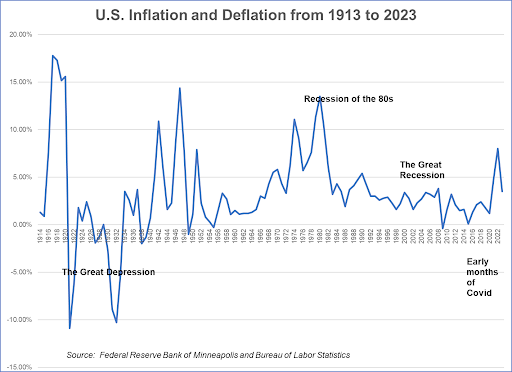A Closer Look at Food Inflation
written by Pam Ferrara for the Salem Reporter


November 21, 2023
Going to the grocery store has become an experience in sticker shock – it seems that everything in the store is increasing in price.
The largest price increases actually occurred in 2022 when overall prices, and many food item prices especially, increased by the largest percentage since the recession of the 1980s. In 2023, most price increases moderated considerably. However, some food items have increased in price by small percentages, compounding the sticker shock – more on food later in the column.
To better understand what is going on and why, let’s review some basic facts about how inflation is measured. Then we’ll look at some specific items from last year to this, and see how well our experience measures up with information from the federal Bureau of Labor Statistics on price changes over the last two years.
Here’s how the process begins. A small army of shoppers go out into the field and collect information on prices of what is called a typical market basket of consumer items. Thousands of items are priced in each of eight categories of consumer goods. (For the list of all items for which prices are gathered, as well as what is excluded in each category, click here.)
Then, an index, called the Consumer Price Index, is created, so that prices can be compared over time. The percentage change in the index is calculated from month to month and the change, almost always positive, is the measure of inflation. For more detail on this process, see the Consumer Price Index frequently asked questions.
But, does all this apply to the experiences of Salem shoppers?
Mostly yes. Consumer items are chosen as being representative of typical urban households’ buying habits, and urban households comprise 90 percent of the U.S. population. One exception would be if household consumer expenditures were unusual in some way. If a person didn’t drive, for example, the price of gasoline wouldn’t have as big an impact on the budget, although indirectly it could, as we’ll see later.
It is interesting to note that the Bureau of Labor Statistics has been measuring inflation by means of changes in the Consumer Price Index since 1913 (see graph one, next page).

The highest inflation post-WWII, 14 percent, occurred in 1947, and the next highest, nearly 14 percent, during the recession of the 1980s. The highest inflationary period since then was last year, 2022 – at eight percent.
Deflation has occurred as well. That’s when the overall price level goes down instead of up. But, after the deflation of the 1930s great depression, deflation has occurred only twice, between 2008 and 2009, the beginning of the Great Recession; and early on in the pandemic. The pandemic-related decline lasted a few months and inflation was slightly positive for the entire year of 2020.
Now, to some detail about prices.
Although inflation in 2022 was the highest since the 1980s, double-digit price increases occurred for only two groups of consumer items, transportation (by 15 percent), and food and beverages (by nearly 11 percent) (see graph, next page).

The price increase in transportation items was driven by a 34 percent price increase of one item, gasoline.
Some individual food items increased by substantially more than 11 percent in 2022 (see table, cont. next page).
Percentage Change in Prices of Selected Food Items October 2021 to October 2023 |
||
| October 2021-22 | October 2022-23 | |
| All Food | 10.9 | 3.3 |
| Eggs | 43 | -22.2 |
| Butter | 26.7 | -3.7 |
| Flour | 24.6 | 3.2 |
| Salad Dressing | 19.7 | 4 |
| Lettuce | 17.7 | -4.5 |
| Olives, pickles and relishes | 17.5 | 4.3 |
| Potatoes | 15.2 | -3.3 |
| Rice | 14.8 | 1.4 |
| Cereal | 16.9 | 3.6 |
| Cookies | 16.8 | 5.1 |
| Processed Fruits and Vegetables | 15.9 | 4.8 |
| Potatoes | 15.2 | -3.3 |
| Bread | 14.8 | 6.3 |
| Coffee | 14.8 | 0.4 |
| Chicken | 14.5 | -0.4 |
| Milk | 14.5 | -1.6 |
| Carbonated drinks | 13.2 | 3.1 |
| Dried beans, peas and lentils | 11.9 | 1.2 |
| Fresh Fruits and Vegetables | 7.4 | -0.1 |
| Beef and Veal | -3.6 | 8.9 |
| Source: BLS CPI All Urban Consumers | ||
Egg prices were off the charts, followed by prices for flour and flour-based products. This was in contrast to meat items, which actually – according to official measurements – dropped a bit in price.
Fresh fruit and vegetable prices increased by a modest amount (7.4 percent) with a few exceptions, but prices of processed fruits and vegetables increased by more than double that percentage.
In 2023 food prices moderated somewhat, although many food items still increased by small percentages.
Why the large price increases for food?
Food is, generally speaking, price inelastic. That means no matter what it costs, consumers still buy food. Item substitution may occur, but overall, demand for food is constant.
Supply of food is a different story. Food prices are largely determined by the most basic economic law of all, that of supply and demand. If the supply of food decreases for whatever reasons, and demand stays the same, food prices go up.
A classic example is the huge increase in the price of eggs last year. Lots of chickens got sick with bird flu and couldn’t lay as many eggs. Supply shortages occurred and egg prices went up.
The substantial price increases for flour and flour-based items is a bit more complicated to explain. The usual suspects affecting the flour supply were: supply chain problems because of Covid; transportation costs (the price of gas going up dramatically – so, even if a person didn’t drive, the price of gas affected food costs); and the war in Ukraine.
The dramatically increased prices of processed fruits and vegetables are generally blamed on rising labor costs.
Two additional causes of food inflation are: the weather; and an increase in demand. These two causes together are thought to be the culprits for the large rise in the price of potatoes last year – hot dry weather, and an increased demand for potatoes in European countries, leading to the US exporting more potatoes, decreasing the supply and raising the price.
There’s one more possible cause of rising food prices that has received some attention from the Biden administration – anti-competitive markets in agriculture and related industries. Last July the White House Competition Council instructed the federal Department of Agriculture to work with Attorneys General in 31 states to address these practices. Oregon is on board with this initiative.
What does all this mean? At the very least, when food prices increase it’s a problem for consumers, who have to eat. However, the average family spends a far smaller portion of the monthly budget on food than ever – about 11 percent. A family in 1950 spent nearly a third of its budget on food.
Double-digit price increases of food items in 2022 seem to be over for now. But some commentators are already talking about the possible economic consequences of the war between Israel and Gaza.– resulting in “geopolitical shocks” that could reverberate around the world. Food and oil are the two items most susceptible to these. Only time will tell if the respite from rising food prices is temporary.
Pam Ferrara of the Willamette Workforce Partnership continues a regular column examining local economic issues. She may be contacted at [email protected]
